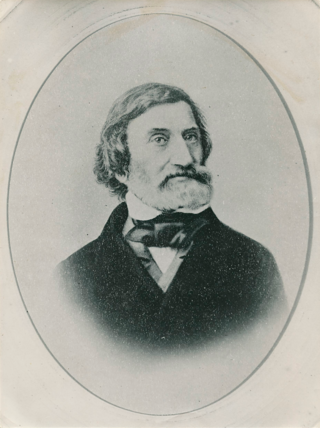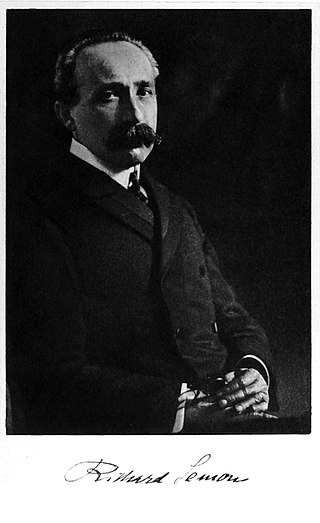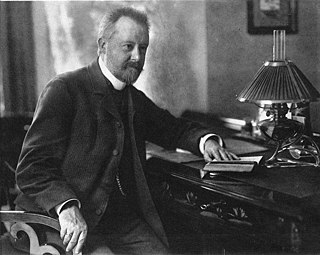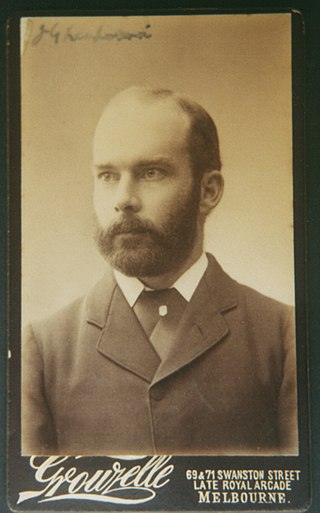
The Order of the Black Eagle was the highest order of chivalry in the Kingdom of Prussia. The order was founded on 17 January 1701 by Elector Friedrich III of Brandenburg. In his Dutch exile after World War I, deposed Emperor Wilhelm II continued to award the order to his family. He made his second wife, Princess Hermine Reuss of Greiz, a Lady in the Order of the Black Eagle.

Carl Ludwig Christian Rümker was a German astronomer.

Richard Wolfgang Semon was a German zoologist, explorer, evolutionary biologist, a memory researcher who believed in the inheritance of acquired characteristics and applied this to social evolution. He is known for coining the terms engram and ecphory.

Lőwy Hevesi Lajos, or Ludwig Hevesi was a Hungarian journalist and writer.
Johann August Ludwig Preiss was a German-born British botanist and zoologist.

Moritz Richard Schomburgk, generally known as Richard Schomburgk, was a German botanist and curator of the Adelaide Botanic Garden.
Karl Theodor Staiger was a German chemical analyst, naturalist and museum curator. Karl Theodor Staiger worked as a chemist for the Queensland Government 1873–80 and worked with Nicholas Miklouho-Maclay. He was secretary to the Queensland Museum from 1876 to 1879.

Gustav Falke was a German writer.

Johann Baptist Mehler was a German Catholic priest, prelate, and religious writer of the Roman Catholic Diocese of Regensburg.

Hermann Ritter was a German viola player, composer and music historian.
Johann Freiderich Carl Wilhelmi (1829–1884) was a Dresden born seedsman who made large collections of botanical specimens in southern Australia.
Members of the Bavarian Maximilian Order for Science and Art, awarded to acknowledge and reward excellent and outstanding achievements in the fields of science and art. It is based in Bavaria, Germany.
George Henry Frederick Ulrich FGS was a notable New Zealand mineralogist, university professor and director of the school of mines.

Diedrich Henne was a German-born botanist and plant collector. He emigrated to Australia and was employed as an assistant to the colonial botanist Ferdinand von Mueller at the Melbourne Herbarium.

Friedrich Edouard Heinrich Wulf Krichauff was a politician in colonial South Australia.

Johann George Luehmann was an Australian botanist, who served as the Assistant Botanist and, later, as the Curator at the National Herbarium of Victoria, and who also, from 1896, served as the Government Botanist of Victoria.
Carl Wilhelm Ludwig Muecke, occasionally written Mücke and frequently referred to as "Dr Muecke", was a German-born clergyman, plant pathologist and German-language newspaper editor in the colony of South Australia. In 1869 he left for the neighbouring colony of Victoria.

Robert von Sterneck was a member of the Budweis Daublebsky von Sterneck baronial family who served as an Austro-Hungarian general major, geophysicist and astronomer. He studied in Prague and entered the Austro-Hungarian Army in 1859, participating in the Magenta und Solferino campaign that year and in the Austro-Prussian War of 1866. From 1862 to 1880, he served head of the astronomical-geodetic section of the military geographic institute in Vienna, and from 1880 to 1902 as the head of the institute's astronomical observatory. He led numerous geodetic missions in the Balkans during the 1870s.

Dr. Hermann Beckler was a German doctor with an interest in botany. He went to Australia to collect specimen for Ferdinand von Mueller and served as medical officer and botanist for the Victoria Exploring Expedition in 1860.

Ludwig Julius Eisenberg was an Austrian writer and encyclopedist. He wrote a lexicon of stage artists, among other publications.














